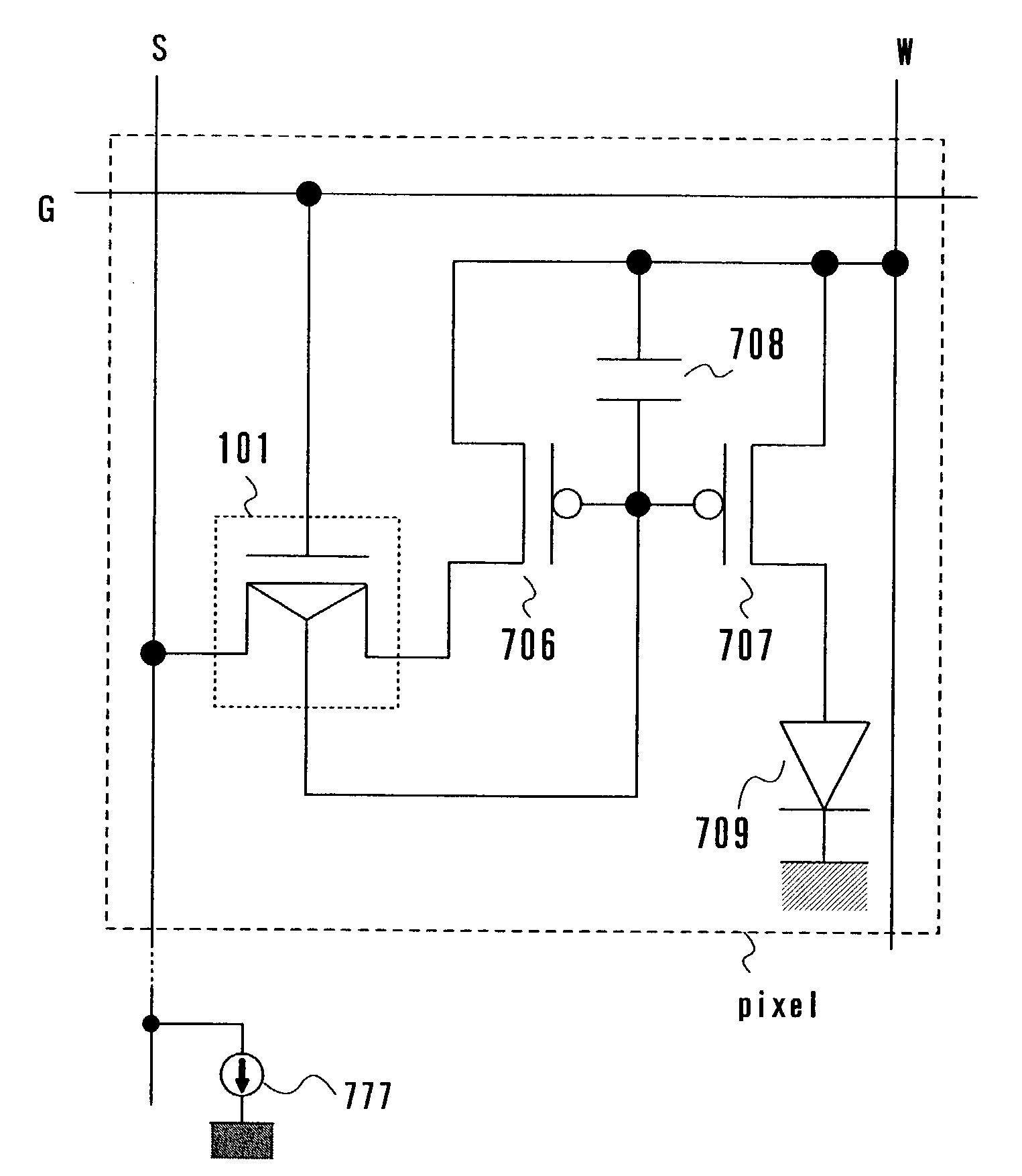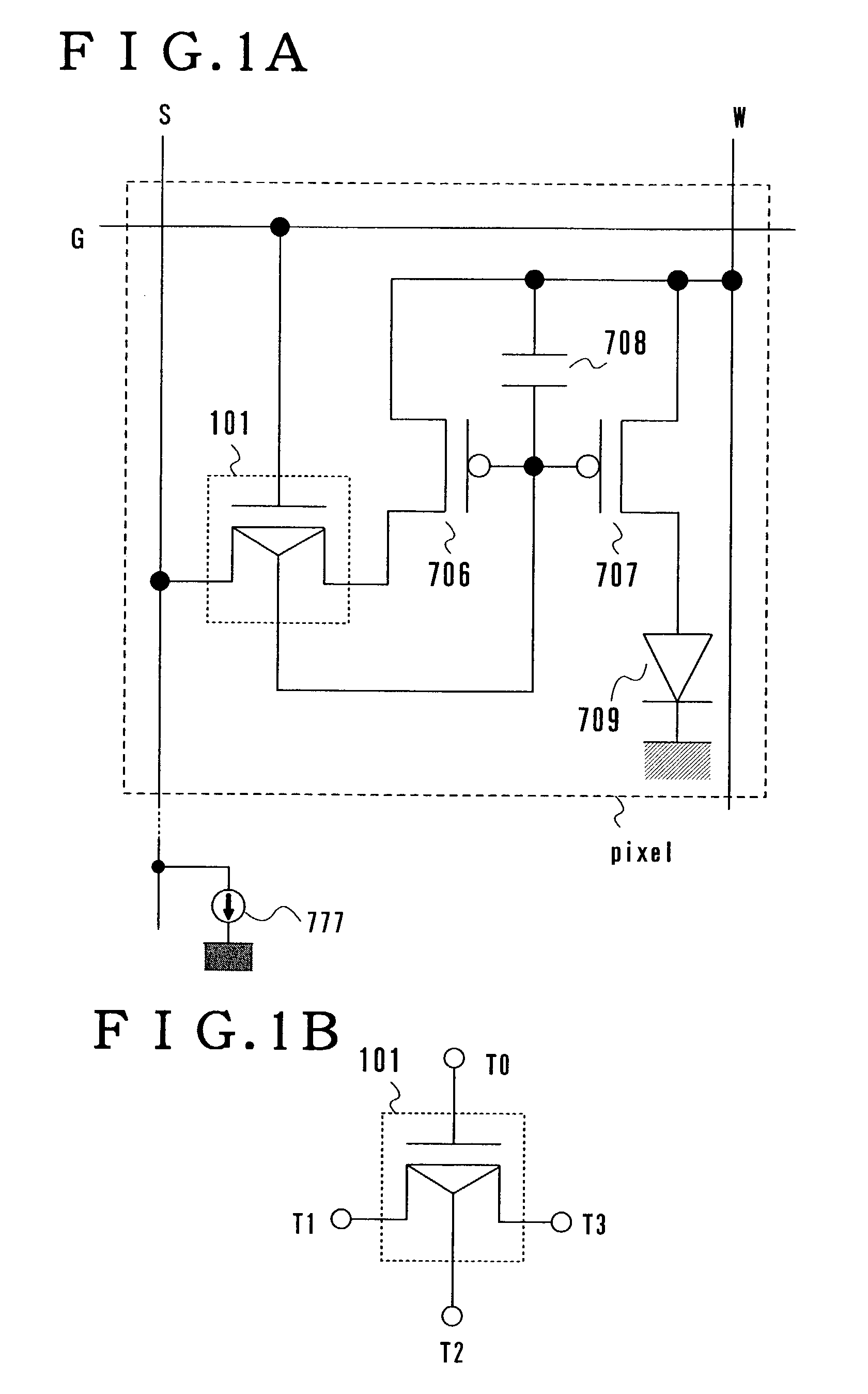Display device
a display device and display technology, applied in the field of display devices, can solve problems such as brightness due to brightness fluctuations, and achieve the effect of constant brightness and decreasing brightness changes
- Summary
- Abstract
- Description
- Claims
- Application Information
AI Technical Summary
Benefits of technology
Problems solved by technology
Method used
Image
Examples
embodiment 1
[0172]The embodiment 1 deals with the constitution of a multi-drain element and the constitution of a pixel in the display device of the invention using the multi-drain element. FIG. 1A illustrates the constitution of the pixel using the multi-drain element of the invention. In FIG. 1A, the portions same as those of the conventional pixel constitution shown in FIG. 10 are denoted by the same reference numerals but their description is not repeated. FIG. 1A illustrates a case where a drive TFT 707 and a current TFT 706 are the p-channel TFTs, and the pixel electrode is an anode.
[0173]FIG. 1A employs a multi-drain element 101 instead of the select TFT 704 and holding TFT 705 used in FIG. 10. Terminals of the multi-drain element 101 in FIG. 1A will be described with reference to FIG. 1B. The multi-drain element 101 has a terminal T0 and terminals T1 to T3.
[0174]Depending upon a signal potential input to the terminal T0, the multi-drain element 101 selects a state where the terminals T1...
embodiment 2
[0213]The embodiment 2 deals with the pixel of a constitution different from that of the embodiment 1. FIG. 5 illustrates the constitution of the pixel of this embodiment. The portions same as those of FIGS. 1A–B are denoted by the same reference numerals but are not described here again. The pixel of the constitution shown in FIG. 5 is provided with an erasing TFT 501 in parallel with the holding capacitor 708. The erasing TFT 501 and the holding capacitor 708 need not necessarily be connected in parallel. When rendered conductive, the erasing TFT 501 may be so connected as to nearly equalize the potentials at both electrodes of the holding capacity 708. Owing to the above constitution, the electric charge held by the holding capacity 708 can be discharged by rendering the erasing TFT 501 conductive. Thus, the drive TFT 707 is rendered nonconductive. In the pixel in which the drive TFT 707 is rendered nonconductive, the EL element 709 does not emit light.
[0214]Here, the gate electr...
embodiment 3
[0233]This embodiment deals with the pixels of a constitution different from those of the pixels illustrated in the embodiments 1 and 2. FIGS. 8A and 8B illustrate the constitution of the pixel according to the embodiment 3. In FIGS. 8A and 8B, the same portions as those of FIGS. 1A–B and 5 are denoted by the same reference numerals, but their description is not repeated. In FIGS. 8A and 8B, the drive TFT 707 and the current TFT 706 in the pixel are the P-channel transistors, and the pixel electrode is an anode.
[0234]In FIGS. 8A and 8B, the first terminal of the current TFT 706, the gate electrode of the drive TFT 707 and the source signal line S are connected to one of different terminals T1 to T3 of the multi-drain element 101. Further, the first terminal of the current TFT 706 is connected to the gate electrode, and the second terminal of the current TFT 706 is connected to the power line W. The first terminal of the drive TFT 707 is connected to one electrode (anode) of the EL e...
PUM
 Login to View More
Login to View More Abstract
Description
Claims
Application Information
 Login to View More
Login to View More - R&D
- Intellectual Property
- Life Sciences
- Materials
- Tech Scout
- Unparalleled Data Quality
- Higher Quality Content
- 60% Fewer Hallucinations
Browse by: Latest US Patents, China's latest patents, Technical Efficacy Thesaurus, Application Domain, Technology Topic, Popular Technical Reports.
© 2025 PatSnap. All rights reserved.Legal|Privacy policy|Modern Slavery Act Transparency Statement|Sitemap|About US| Contact US: help@patsnap.com



